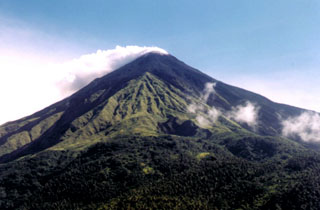Report on Karangetang (Indonesia) — 4 August-10 August 2010
Smithsonian Institution / US Geological Survey
Weekly Volcanic Activity Report, 4 August-10 August 2010
Managing Editor: Sally Sennert.
Please cite this report as:
Global Volcanism Program, 2010. Report on Karangetang (Indonesia) (Sennert, S, ed.). Weekly Volcanic Activity Report, 4 August-10 August 2010. Smithsonian Institution and US Geological Survey.
Karangetang
Indonesia
2.781°N, 125.407°E; summit elev. 1797 m
All times are local (unless otherwise noted)
According to news articles, an eruption from Karangetang on 6 August produced pyroclastic flows on the W flank that destroyed at least seven houses. A hot ash plume rose above the crater, and incandescent material was ejected from the crater and descended multiple flanks. At least four people were missing, five were injured, and about 65 were evacuated. An article also stated that CVGHM raised the Alert Level to 3 (on a scale of 1-4). According to reports from CVGHM and analyses of satellite imagery, the Darwin VAAC reported that an ash plume rose to an altitude of 9.1 km (30,000 ft) a.s.l. and drifted W.
Geological Summary. Karangetang (Api Siau) volcano lies at the northern end of the island of Siau, about 125 km NNE of the NE-most point of Sulawesi. The stratovolcano contains five summit craters along a N-S line. It is one of Indonesia's most active volcanoes, with more than 40 eruptions recorded since 1675 and many additional small eruptions that were not documented (Neumann van Padang, 1951). Twentieth-century eruptions have included frequent explosive activity sometimes accompanied by pyroclastic flows and lahars. Lava dome growth has occurred in the summit craters; collapse of lava flow fronts have produced pyroclastic flows.
Sources: Associated Press, Darwin Volcanic Ash Advisory Centre (VAAC), CNN

